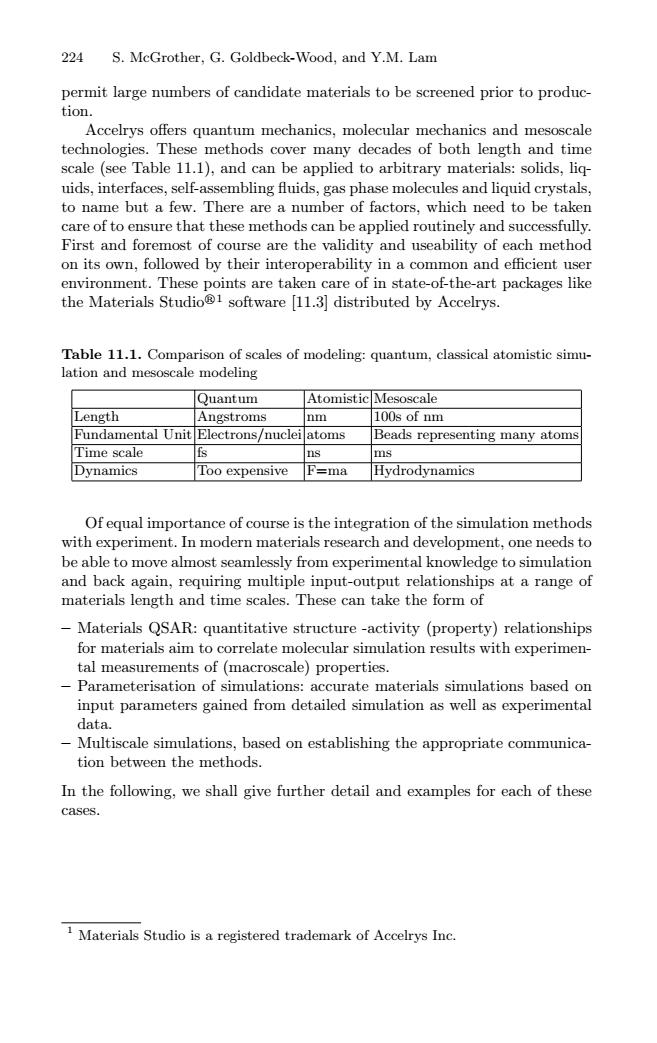正在加载图片...

224 S.McGrother.G.Goldbeck-Wood,and Y.M.Lam permit large numbers of candidate materials to be screened prior to produc- tion. Accelrys offers quantum mechanics,molecular mechanics and mesoscale technologies.These methods cover many decades of both length and time scale(see Table 11.1),and can be applied to arbitrary materials:solids,liq- uids,interfaces,self-assembling fuids,gas phase molecules and liquid crystals, to name but a few.There are a number of factors,which need to be taken care of to ensure that these methods can be applied routinely and successfully First and foremost of course are the validity and useability of each method on its own,followed by their interoperability in a common and efficient user environment.These points are taken care of in state-of-the-art packages like the Materials Studio1 software [11.3]distributed by Accelrys. Table 11.1.Comparison of scales of modeling:quantum,classical atomistic simu- lation and mesoscale modeling Quantum AtomisticMesoscale Length Angstroms nm 100s of nm Fundamental Unit Electrons/nucleiatoms Beads representing many atoms T'ime scale 因 ns ms Dynamics Too expensive F=ma Hydrodynamics Of equal importance of course is the integration of the simulation methods with experiment.In modern materials research and development,one needs to be able to move almost seamlessly from experimental knowledge to simulation and back again,requiring multiple input-output relationships at a range of materials length and time scales.These can take the form of -Materials QSAR:quantitative structure -activity (property)relationships for materials aim to correlate molecular simulation results with experimen- tal measurements of(macroscale)properties. Parameterisation of simulations:accurate materials simulations based on input parameters gained from detailed simulation as well as experimental data. Multiscale simulations,based on establishing the appropriate communica- tion between the methods. In the following,we shall give further detail and examples for each of these cases. 1 Materials Studio is a registered trademark of Accelrys Inc.224 S. McGrother, G. Goldbeck-Wood, and Y.M. Lam permit large numbers of candidate materials to be screened prior to production. Accelrys offers quantum mechanics, molecular mechanics and mesoscale technologies. These methods cover many decades of both length and time scale (see Table 11.1), and can be applied to arbitrary materials: solids, liquids, interfaces, self-assembling fluids, gas phase molecules and liquid crystals, to name but a few. There are a number of factors, which need to be taken care of to ensure that these methods can be applied routinely and successfully. First and foremost of course are the validity and useability of each method on its own, followed by their interoperability in a common and efficient user environment. These points are taken care of in state-of-the-art packages like the Materials Studio1 software [11.3] distributed by Accelrys. Table 11.1. Comparison of scales of modeling: quantum, classical atomistic simulation and mesoscale modeling Quantum Atomistic Mesoscale Length Angstroms nm 100s of nm Fundamental Unit Electrons/nuclei atoms Beads representing many atoms Time scale fs ns ms Dynamics Too expensive F=ma Hydrodynamics Of equal importance of course is the integration of the simulation methods with experiment. In modern materials research and development, one needs to be able to move almost seamlessly from experimental knowledge to simulation and back again, requiring multiple input-output relationships at a range of materials length and time scales. These can take the form of – Materials QSAR: quantitative structure -activity (property) relationships for materials aim to correlate molecular simulation results with experimental measurements of (macroscale) properties. – Parameterisation of simulations: accurate materials simulations based on input parameters gained from detailed simulation as well as experimental data. – Multiscale simulations, based on establishing the appropriate communication between the methods. In the following, we shall give further detail and examples for each of these cases. 1 Materials Studio is a registered trademark of Accelrys Inc